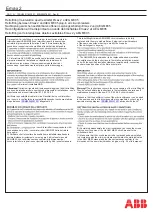
22
Instruction Book
IB182217EN October 2018 www.eaton.com
50 / 75 / 150 DHP [Cable or Hard Bus Application]
Ground and Test Device
SECTION 5: INSTALLATION & INSPECTION
m
WARNING
BEFORE PLACING THE GROUND AND TEST DEVICE IN SERVICE, CAREFULLY
FOLLOW THE INSTALLATION PROCEDURE BELOW AND THE SAFE
PRACTICES SET FORTH IN SECTION 2. NOT FOLLOWING THE PROCEDURE
MAY RESULT IN INCORRECT G&T DEVICE OPERATION LEADING TO DEATH,
BODILY INJURY, AND PROPERTY DAMAGE.
When the G&T device is first used and each time it is used in the
future, it should be carefully examined and checked to make sure it
is operating correctly.
5.1 EXAMINATION FOR DAMAGE
Examine the ground and test device for loose or obviously damaged
parts. Never attempt to install nor operate a damaged ground and
test device.
5.1.1 NAMEPLATE VERIFICATION
Verify the information on the new G&T device matches the
information on the purchase order. If any discrepancies exist, notify
Eaton for resolution prior to proceeding.
5.3 SNUBBER ADJUSTMENT
m
NOTICE
FOR ALL TYPE DHP HOUSINGS, THE ADJUSTMENT STEPS OUTLINED IN
THIS PARAGRAPH MUST BE PERFORMED BEFORE INSTALLING A DHP
GROUND AND TEST DEVICE. FAILURE TO COMPLETE THESE STEPS COULD
RESULT IN EQUIPMENT DAMAGE AND/OR IMPROPER OPERATION.
Before levering a ground and test device into any and all housings,
the snubber bolts must be adjusted as outlined in steps 1 and 2.
Refer to Figures Set 3.3 and Figure 5.2 for reference purposes. If a
ground and test device is moved from one housing to another, the
procedure must be repeated for the new housing.
Step 1: Measure the distance from the floor plate to the underside
of the current transformer shelf on both sides of the housing in line
with the location of the snubber bolts on each side of the ground
and test device (Figure 5.1).
Step 2: Adjust the height of the top of the snubber bolt to be
between 0.0 and 0.031 (0.0 and 1/32) inches below the measured
height of the current transformer shelf and tighten the locking nut.
5.2 INSERTION PROCEDURES
m
NOTICE
THIS IS NOT A BREAKER OR AN ELECTRICALLY OPERATED GROUND AND
TEST DEVICE. THEREFORE THERE IS NO SECONDARY BLOCK. THIS MEANS
THAT THERE IS NO TEST POSITION AND IT WILL NOT BE COVERED IN THIS
INSTRUCTION MANUAL.
ENSURE THAT GROUNDING CABLES ARE INSTALLED PROPERLY BEFORE
INSERTING GROUND AND TEST DEVICE INTO CELL.
WHILE LEVERING THE GROUND AND TEST DEVICE, NOTE ANY SUDDEN
RESISTANCE TO LEVERING OR SIGNS OF BINDING. DETERMINE THE
CAUSE OF INTERFERENCE AND CORRECT, AS APPROPRIATE, BEFORE
PROCEEDING.
Press down on the rail latch on the front right side of the G&T device
with your foot, and push the G&T device toward the rear of the cell
Figure 5.1. Current Transformer Shelf
5.2 INSTALLATION OF GROUNDING CABLES
NOTE: USE HARDWARE PROVIDED WITH THE GROUND & TEST
DEVICE INSTALLED AS SHOWN. (Figure 5.3)
a. Determine the set of terminals required for each occasion.
b. Using the key provided (Figure 3-3) with each G&T device, unlock
the appropriate door, exposing the terminals. This feature is not
applicable for single terminal ground and test devices.
c. Using 0.5-inch hardware provided, attach one end of each of the
three grounding cables to a terminal corresponding to each phase.
(Figure 4-3). Hardware should be torqued to 50 ft-lbs.
d. Cables are bolted to the ground plate at the factory. If they have
been unbolted, reattach the terminal of the grounding cables to the
copper ground bar located at the front of the truck frame. Hardware
should be torqued to 50 ft-lbs.
Figure 5.2. Adjustments for Anti-Rotation Hold Downs
(Shown Separate From Breaker For Clarity)































